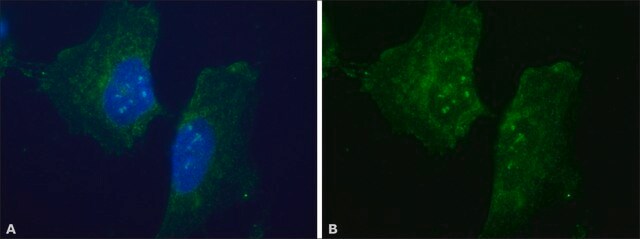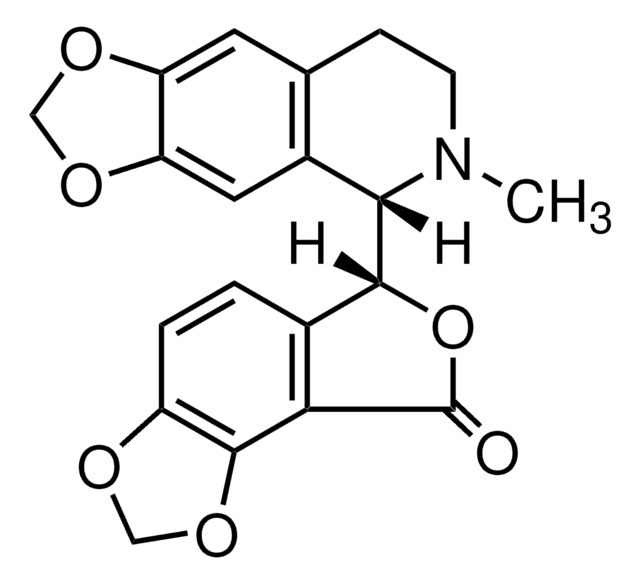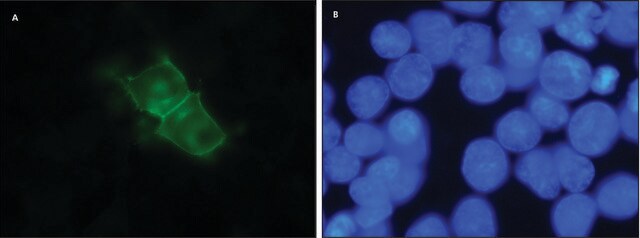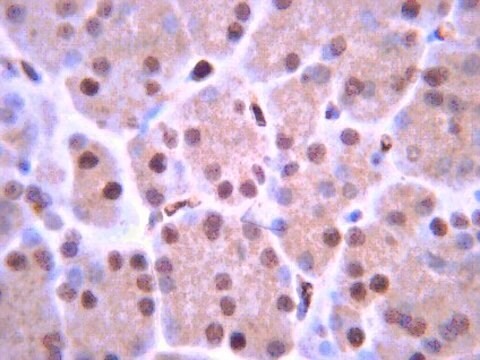推荐产品
生物源
mouse
品質等級
抗體表格
purified immunoglobulin
抗體產品種類
primary antibodies
無性繁殖
K56A, monoclonal
物種活性
rat
製造商/商標名
Chemicon®
技術
immunohistochemistry: suitable
同型
IgG
運輸包裝
dry ice
目標翻譯後修改
unmodified
基因資訊
rat ... Slc6A3(24898)
特異性
Dopamine.
The cross-reactivities were determined using an ELISA test by competition experiments with the following compounds:
Compound Cross-reactivity
Dopamine-G-BSA 1
L-DOPA-G-BSA 1/10,000
Tyrosine-G-BSA 1/36,000
Tyramine-G-BSA 1/>50,000
Noradrenaline-G-BSA 1/>50,000
Octopamine-G-BSA 1/>50,000
Adrenaline-G-BSA 1/>50,000
Dopamine 1/>50,000
Abbreviations:
(G) Glutaraldehyde
(BSA) Bovine Serum Albumin
The cross-reactivities were determined using an ELISA test by competition experiments with the following compounds:
Compound Cross-reactivity
Dopamine-G-BSA 1
L-DOPA-G-BSA 1/10,000
Tyrosine-G-BSA 1/36,000
Tyramine-G-BSA 1/>50,000
Noradrenaline-G-BSA 1/>50,000
Octopamine-G-BSA 1/>50,000
Adrenaline-G-BSA 1/>50,000
Dopamine 1/>50,000
Abbreviations:
(G) Glutaraldehyde
(BSA) Bovine Serum Albumin
免疫原
Dopamine-Gluteraldehyde-BSA.
應用
Anti-Dopamine Antibody, clone K56A detects level of Dopamine & has been published & validated for use in IH.
Immunohistochemistry: 1:500-1:2,500 using free floating sections by the PAP technique on rat dopaminergic areas.
Optimal working dilutions must be determined by end user.
PROTOCOL for Dopamine Detection by Immunohisto/cytochemistry. Example for a rat brain.
1. SOLUTIONS TO BE PREPARED - Solution must be prepared as needed.
Solution A: 0.1M cacodylate, 10g/L sodium metabisulfite, pH 6.2.
Solution B: 0.1M cacodylate, 10g/L sodium metabisulfite, 3-5% glutaraldehyde, pH 7.5.
2. RAT PERFUSION - The rat is anaesthetized with sodium pentobarbital or Nembutal and perfused intracardially through the aorta using a pump with Solution A (30 mL): 150-300 mL/min, Solution B (500 mL): 150-300 mL/min.
3. POST FIXATION: 15 to 30 minutes in Solution B, then 4 soft washes in 0.05M Tris with 8.5 g/L sodium metabisulfite, pH 7.5 (Solution C) .
4. TISSUE SECTIONING: Vibratome or cryostat sections can be used.
5. REDUCTION STEP: Sections are reduced with Solution C containing 0.1M sodium borohydride for 10 minutes. The sections are washed 4 times in solution C without sodium borohydride.
6. APPLICATION OF DOPAMINE ANTIBODY: Use a final dilution of 1:2,500-1:10,000 in Solution C containing 0.1% Triton X100 and 2% non-specific serum. Incubate 12 sections per 2 mL diluted antibody overnight, +4°C. Then wash the sections three times for 10 minutes each in Solution C. (Note that the antibody may be usable at a higher dilution. This should be explored to minimize the possibility of high background. Additionally, note that a change in the buffering system as indicated in the protocol may change the background and antibody recognition). The specific reaction is then revealed by PAP procedure.
6. SECOND ANTIBODY: Incubate the sections with a 1:50 to 1:200 dilution of goat anti-rabbit in Solution B containing 1% non-specific serum for either 3 hrs at 20°C or 2 hr at 37°C. Then wash the sections, 3 times, for 10 minutes each with Solution B.
7. PAP: Incubate the sections with the appropriate dilution of peroxidase anti-peroxidase (for free floating method) in Solution B containing 1% non-specific serum for 1-2 hours at 37°C. Then wash sections 3 times for 10 min each in solution B.
8. VISUALIZATION: The antigen-antibody complexes are visualized using DAB-4-HCl (25 mg/100 mL) (or other chromogen) in 0.05M Tris and filtrated; 0.05% hydrogen peroxide is added. Incubate the sections for 10 minutes at room temp. Stop the reaction by transferring the sections to 5 mL 0.05M Tris. Wash tissue with solution D using 2, 10 min washes. Mount sections on chrome-alum coated slides. Dry overnight at 37°C. Rehydrate sections using conventional histological procedures. Coverslip using rapid mounting media.
For research use only; not for use as a diagnostic.
Optimal working dilutions must be determined by end user.
PROTOCOL for Dopamine Detection by Immunohisto/cytochemistry. Example for a rat brain.
1. SOLUTIONS TO BE PREPARED - Solution must be prepared as needed.
Solution A: 0.1M cacodylate, 10g/L sodium metabisulfite, pH 6.2.
Solution B: 0.1M cacodylate, 10g/L sodium metabisulfite, 3-5% glutaraldehyde, pH 7.5.
2. RAT PERFUSION - The rat is anaesthetized with sodium pentobarbital or Nembutal and perfused intracardially through the aorta using a pump with Solution A (30 mL): 150-300 mL/min, Solution B (500 mL): 150-300 mL/min.
3. POST FIXATION: 15 to 30 minutes in Solution B, then 4 soft washes in 0.05M Tris with 8.5 g/L sodium metabisulfite, pH 7.5 (Solution C) .
4. TISSUE SECTIONING: Vibratome or cryostat sections can be used.
5. REDUCTION STEP: Sections are reduced with Solution C containing 0.1M sodium borohydride for 10 minutes. The sections are washed 4 times in solution C without sodium borohydride.
6. APPLICATION OF DOPAMINE ANTIBODY: Use a final dilution of 1:2,500-1:10,000 in Solution C containing 0.1% Triton X100 and 2% non-specific serum. Incubate 12 sections per 2 mL diluted antibody overnight, +4°C. Then wash the sections three times for 10 minutes each in Solution C. (Note that the antibody may be usable at a higher dilution. This should be explored to minimize the possibility of high background. Additionally, note that a change in the buffering system as indicated in the protocol may change the background and antibody recognition). The specific reaction is then revealed by PAP procedure.
6. SECOND ANTIBODY: Incubate the sections with a 1:50 to 1:200 dilution of goat anti-rabbit in Solution B containing 1% non-specific serum for either 3 hrs at 20°C or 2 hr at 37°C. Then wash the sections, 3 times, for 10 minutes each with Solution B.
7. PAP: Incubate the sections with the appropriate dilution of peroxidase anti-peroxidase (for free floating method) in Solution B containing 1% non-specific serum for 1-2 hours at 37°C. Then wash sections 3 times for 10 min each in solution B.
8. VISUALIZATION: The antigen-antibody complexes are visualized using DAB-4-HCl (25 mg/100 mL) (or other chromogen) in 0.05M Tris and filtrated; 0.05% hydrogen peroxide is added. Incubate the sections for 10 minutes at room temp. Stop the reaction by transferring the sections to 5 mL 0.05M Tris. Wash tissue with solution D using 2, 10 min washes. Mount sections on chrome-alum coated slides. Dry overnight at 37°C. Rehydrate sections using conventional histological procedures. Coverslip using rapid mounting media.
For research use only; not for use as a diagnostic.
Research Category
Neuroscience
Neuroscience
Research Sub Category
Neurotransmitters & Receptors
Neurotransmitters & Receptors
外觀
Format: Purified
Purified immunoglobulin. Liquid containing 50% glycerol.
儲存和穩定性
Maintain at -20°C in undiluted aliquots for up to 6 months after date of receipt.
法律資訊
CHEMICON is a registered trademark of Merck KGaA, Darmstadt, Germany
免責聲明
Unless otherwise stated in our catalog or other company documentation accompanying the product(s), our products are intended for research use only and are not to be used for any other purpose, which includes but is not limited to, unauthorized commercial uses, in vitro diagnostic uses, ex vivo or in vivo therapeutic uses or any type of consumption or application to humans or animals.
未找到合适的产品?
试试我们的产品选型工具.
儲存類別代碼
12 - Non Combustible Liquids
水污染物質分類(WGK)
WGK 2
閃點(°F)
Not applicable
閃點(°C)
Not applicable
Disruption of dopamine homeostasis underlies selective neurodegeneration mediated by alpha-synuclein.
Soon S Park,Emily M Schulz,Daewoo Lee
The European Journal of Neuroscience null
Yuanzhong Xu et al.
eNeuro, 4(3) (2017-06-01)
Leptin receptors (LepRs) expressed in the midbrain contribute to the action of leptin on feeding regulation. The midbrain neurons release a variety of neurotransmitters including dopamine (DA), glutamate and GABA. However, which neurotransmitter mediates midbrain leptin action on feeding remains
Emma van der Woude et al.
Brain, behavior and evolution, 89(3), 185-194 (2017-05-10)
Trichogramma evanescens parasitic wasps show large phenotypic plasticity in brain and body size, resulting in a 5-fold difference in brain volume among genetically identical sister wasps. Brain volume scales linearly with body volume in these wasps. This isometric brain scaling
Jitte Groothuis et al.
Cell and tissue research, 379(2), 261-273 (2019-08-24)
An extreme reduction in body size has been shown to negatively impact the memory retention level of the parasitic wasp Nasonia vitripennis. In addition, N. vitripennis and Nasonia giraulti, closely related parasitic wasps, differ markedly in the number of conditioning
Philippe-Antoine Beauséjour et al.
The Journal of comparative neurology, 528(1), 114-134 (2019-07-10)
Detection of chemical cues is important to guide locomotion in association with feeding and sexual behavior. Two neural pathways responsible for odor-evoked locomotion have been characterized in the sea lamprey (Petromyzon marinus L.), a basal vertebrate. There is a medial
我们的科学家团队拥有各种研究领域经验,包括生命科学、材料科学、化学合成、色谱、分析及许多其他领域.
联系技术服务部门








